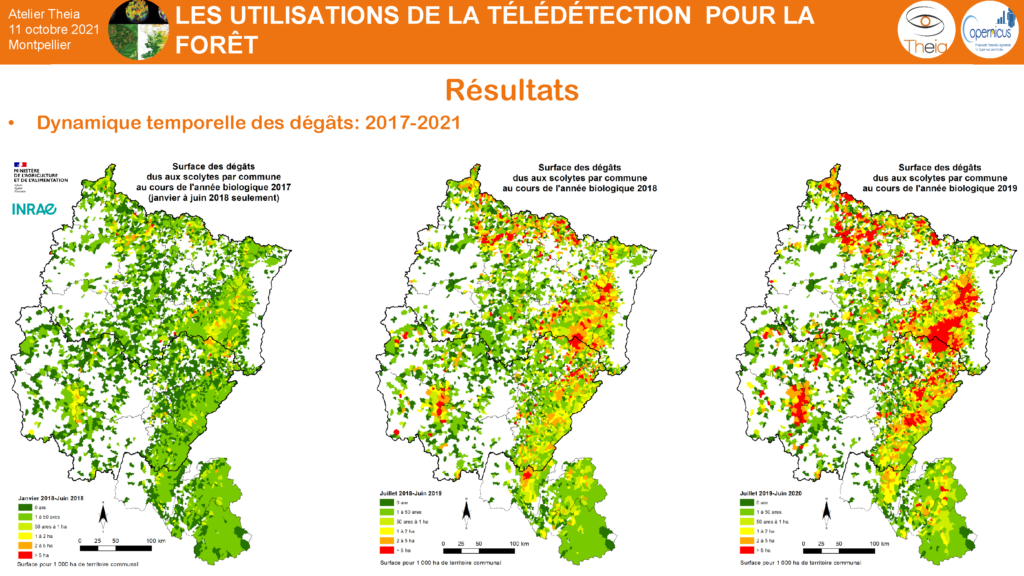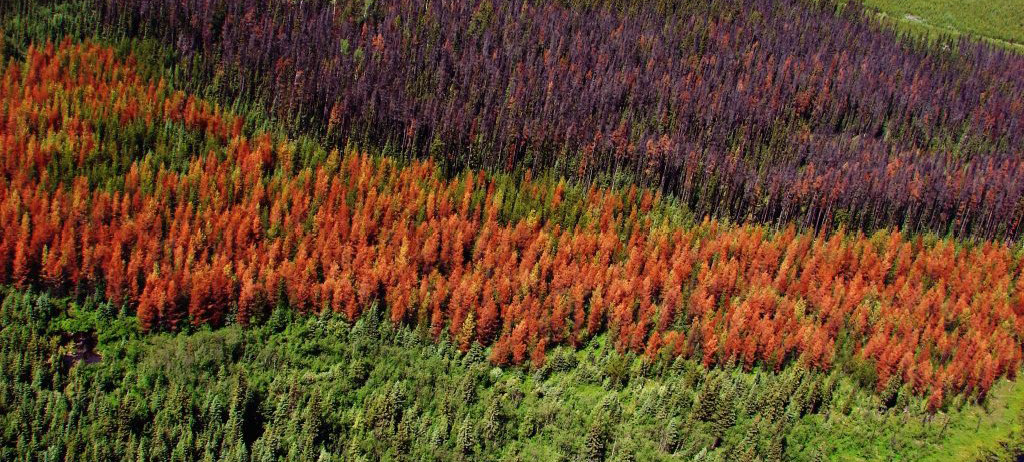Presentation
Theia ‘Changes and Health of Temperate Forests’ group of experts brings together engineers, researchers and stakeholders from the forestry sector, from the ONF, CNPF, DSF, IGN, CNES, TETIS, CESBIO and Dynafor UMRs, the LBLGC laboratory, and many other research teams.
Contributors to this Scientific Expertise develop and implement methods and tools based on remote sensing data to improve silvicultural and sylvo-sanitary monitoring and the sustainable management of temperate forests, in a context where the pressure factors on these ecosystems are increasingly more numerous in France, in Europe, and throughout the world.
Improving tracking of changes in temperate forests
Temperate forests are subject to the effects of global changes directly (water and heat stress, biological invasion) and indirectly (insect outbreaks, fungi, fires, etc.). These factors are causing the explosion of many health problems affecting a variety of softwood and hardwood species and significant excess mortality. In France, bark beetle attacks are currently impacting spruce and fir trees over a large quarter of north-eastern France since 2018, following severe periods of drought. This health crisis has a significant impact on the forest-wood sector, with environmental, economic and social consequences. Elsewhere, many health issues such as chestnut ink, pine sphaeropsis and pine nematode, are the subject of increased surveillance in the forest massifs, because of their proven presence or in order to prevent a significant risk of introduction.
The combination of field observations and remotely-sensed Earth observation data makes it possible to consider operational solutions that meet the need for monitoring across the entire territory of multiple health problems, by producing maps from local to regional scales, with frequent updates, adjustable according to health problems (monthly / yearly). The associated methods will help to assess the surfaces and volumes of wood affected, to study the dynamics and, if possible, to prevent the spread of health issues through early detection.
Objectives
The objectives of the Scientific Expertise ‘Changes and Health of Temperate Forests’ are to :
- Federate research activities and forest experts (public offices & establishment, services of the ministry in charge of forests) in order to propose methods and products resulting from the analysis of remote sensing data allowing to improve monitoring operational health status of French and European temperate forests.
- Respond to the needs of State services and forest management stakeholders.
- Strengthen interdisciplinary collaborations between remote sensing experts and stakeholders in the forest sector in order to promote the exchange of expertise and data necessary for the calibration of prediction models.
- Contribute to ongoing definition of strategies for monitoring the health status of metropolitan forests, integrating space observation capacities and field observation systems that already exist and/or need to be reinforced.
Products expected
Several high-level products will be provided in the frame of the Scientific Expertise:
- Maps of damages caused by spruce and fir bark beetles affecting the north-eastern quarter of France since 2018.
This product is the result of a methodology developed by UMR TETIS as part of the ‘Forest Health’ project (DSF, DGPE, INRAE TETIS, ONF, CNPF). The technical environment of the Scientific Expertise and THEIA will promote the continuity of development and the maintenance of the method currently in place. The production of maps on an annual and seasonal basis can also be ensured within the framework of collaborations with CNES and the THEIA consortium.

- fordead : a python package for vegetation anomalies detection from SENTINEL-2 images
- Clear-cut maps produced by UMR TETIS.
- Forest mask produced by UMR TETIS based on deep learning analysis of very high spatial resolution satellite imagery (national SPOT satellite coverage)
Contacts

Jean-Baptiste Féret
INRAE | TETIS
@JB.Feret

Thierry Belouard
DSF, MAA
@T.Belouard
Board: Anne Jolly (ONF) @A.Jolly | Michel Chartier (CNPF) @M.Chartier | Kenji Ose (UMR TETIS, INRAE) @K.Ose | Sylvie Durrieu (UMR TETIS, INRAE) @S.Durrieu | Mireille Paulin (CNES) @M.Paulin | Véronique Chéret (Dynafor, INPT) @V.Cheret | Cédric Vega (IGN – LIF) @C.Vega

